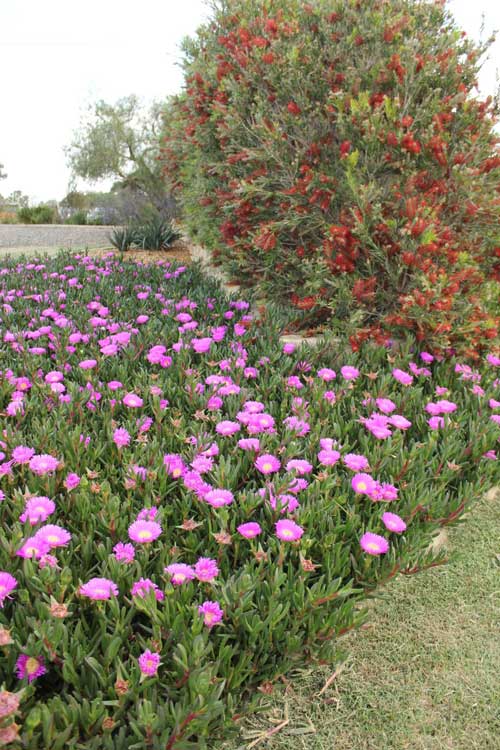While gardening in sandy soil can pose its own unique challenges, it also presents a host of potential benefits. The key to success lies in understanding the nature of sandy soils and selecting the right plants.
In this article, we’ll help you understand everything you need to know to begin gardening successfully in sandy soil.
Not all plants thrive in sandy soils. Which Aussie natives can you plant here?

Understanding Sandy Soils
What is Sandy Soil vs Clay Soil?
Sandy soil, as its name suggests, contains a high proportion of sand particles. This type of soil is typically loose and gritty to the touch due to the large particle size. That’s the exact opposite of clay which is slimy when wet and consists of a much smaller particle size.
Unless you’re on the beach, it’s most likely that there will be other elements like silt, clay and organic matter in the soil composition, but when we say “sandy” soil we’re referring to sand-dominant soils.
Sand-dominant soils are prevalent in many parts of Australia, particularly along the coastline and in Western Australia’s vast interior.
Pros and Cons of Sandy Soils
One of the main advantages of sandy soils is their ease of cultivation. They’re light and airy, making them easy to dig and plant.
However, their large particle size leads to quick water drainage, which can be a double-edged sword. While this rapid drainage prevents waterlogging, it can also lead to drought-like conditions if not properly managed. Most garden plants like regular access to moisture, which can be a struggle in sand-dominated soils.
Furthermore, sandy soils struggle to retain nutrients, which can hinder plant growth. They can also become hydrophobic, meaning that water can’t penetrate the surface, when organic plant waxes fail to become broken down due to a lack of soil organisms. This is usually because there’s not enough moisture to support these organisms, which becomes a self-fulfilling cycle.
The Importance of Choosing the Right Plants for Free Draining Sandy Soils
Adapting to the Environment
Choosing plants that naturally thrive in sandy soils is the first step to successfully gardening in sand. These plants have evolved (or been bred) to survive in these challenging conditions, saving you both effort and resources in the long run.
Enhancing Biodiversity and Pride
Native Australian plants play an important role in promoting biodiversity. By choosing sand-loving native plants for your garden, you’re not only creating a beautiful landscape that won’t struggle in sand, but also contributing to a healthier environment.
Native plants also an expression of national pride, and a love for our native fauna. Who doesn’t love a good, Aussie native plant?
Best Native Plants for Sandy Soil
Sandy soils, while challenging, can be a boon to certain types of plants. The native Australian flora we’re introducing in this section have evolved to thrive in such conditions.
However, remember that when we discuss the suitability of these plants for sandy soils, we’re referring broadly to the genus or species level. Once you delve into specific cultivars, their behaviour might differ from what you’d expect based on their species alone.
Look at this list as a guide and always read the label when choosing and specifying plants.
Kangaroo Paws (Anigozanthos spp.)
Kangaroo Paws are a unique addition to any garden, with their vibrant colours and distinctive form. Native to Australia, these strappy perennials thrive in well-drained sandy soils with full sun exposure. During the flowering season, they require a lot of water. They respond well to heavy pruning, so don’t hesitate to cut back the plants—leaves, flower stalks, and all—to a few cm above the soil line after the flowering season.
Anigozanthos hybrid ‘Gold Velvet’ PBR.
Allocasuarina verticillata
Commonly known as drooping sheoak, allocasuarina verticillata is a hardy evergreen tree that’s well-suited to sandy soils. Its fine, needle-like foliage and ability to withstand wind make it a great choice for coastal gardens. When planting, choose a sunny spot, water well until established, and prune lightly to maintain shape.
Banksia ericifolia
With its striking orange flowers and ability to withstand poor soils, banksia ericifolia, or heath-leaved banksia, is a great addition to sandy soil gardens. It requires full sun and good drainage, and benefits from a light pruning after flowering to promote dense growth.
Eremophila glabra
Eremophila glabra, also known as emu bush, is a hardy shrub that thrives in sandy soils. Its vibrant flowers, which range from red to yellow, attract native birds and bees. Plant in a sunny location, water sparingly once established, and prune after flowering to maintain shape and encourage new growth.
Spinifex sericeus
Spinifex sericeus, or beach spinifex, is a native grass well-adapted to sandy coastal soils. Its ability to stabilise sand dunes makes it an excellent choice for erosion control. Plant in a sunny location, water regularly until established, and trim as needed to maintain desired size.
Lilly pillies
The lilly pilly group, including Waterhousea, Syzygium and Acmena spp., are versatile plants that can handle sandy soils. These evergreen rainforest-dwelling shrubs or trees are known for their glossy foliage and ornamental berries. While Syzygium and Acmena have been combined under the Syzygium genus, many horticulturists still refer to them by their old names. Plant in a sunny or partially shaded location, try to keep the soil moist, especially during dry periods, and prune regularly to maintain desired shape.
Westringia fruticosa
Commonly known as coastal rosemary, Westringia fruticosa is a hardy Australian native that thrives in sandy soils. It’s a versatile plant that can withstand harsh coastal conditions, making it an ideal choice for seaside gardens. Plant in full sun or partial shade, and water regularly until established.
Dianella tasmanica
Dianella tasmanica, also known as Tasman flax lily, is a clump-forming perennial with attractive blue-green foliage and vibrant blue-purple flowers. It’s well-suited to sandy soils and requires minimal watering once established. Plant in a sunny or partially shaded location and prune as necessary to maintain desired shape and size.
Native Pigface (Carpobrotus glaucescens)
Carpobrotus glaucescens, commonly known as pigface, is a succulent groundcover that thrives in sandy soils. It’s resistant to salt spray, making it a great choice for coastal gardens. Plant in full sun and water sparingly—this plant is drought-tolerant and may suffer from root rot if overwatered.
Aussie Rambler™ Carpobrotus glaucescens ‘CAR10’ PBR.
Grevillea spp.
Grevilleas are a diverse group of plants with species that are often well-suited to sandy soils. Their vibrant flowers attract native wildlife, making them a great choice for a biodiverse garden. They generally prefer full sun and well-drained soil. Water during dry periods and prune lightly after flowering to encourage new growth.
Correa spp.
Correas are small Australian shrubs known for their bell-shaped flowers. They’re hardy plants that can withstand a variety of soil types, including sandy soils. Plant in a sunny or partially shaded location and water regularly until established.
Tips for Successful Gardening in Sandy Soils
Problems with Sand
Despite the benefits, gardening in sandy soil is not without its challenges. Identifying these issues is the first step towards addressing them. Some common problems include loose, coarse structure; poor stability; and hydrophobicity, as we discussed above.
Improving Soil Structure
Improving the structure of sandy soils often involves the addition of organic matter such as compost. Over time, plants will naturally add organic matter to soils through their root system and dropping foliage. In turn, this feeds soil biota that help increase organic matter even more as long as the plants continue to photosynthesise.
But remember, without proper watering, nutrient leaching could occur, leaving your soil depleted. Make sure you’re not overwatering, sending your nutrients straight down into the subsoil, away from the reach of your plants.
Amending soil with a quality hydrogel like Terracottem or a kaolin clay like Soil Solver is the best way to help retain moisture in sandy soils long-term.
Mulching can also be beneficial in retaining moisture, while providing additional organic material as it slowly breaks down.
Conclusion
Choosing native Australian plants for your sandy soil garden can bring about a host of benefits. Not only will you be contributing to local biodiversity, but you’ll also be creating a resilient, beautiful landscape. Embrace the challenges that come with sandy soil and reap the rewards of a flourishing garden.


